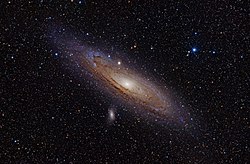NGC 147
| Galaxie NGC 147 | |
|---|---|
 | |
| Amateuraufnahme | |
| AladinLite | |
| Sternbild | Kassiopeia |
| Position Äquinoktium: J2000.0, Epoche: J2000.0 | |
| Rektaszension | 00h 33m 12,12s[1] |
| Deklination | +48° 30′ 31,5″[1] |
| Erscheinungsbild | |
| Morphologischer Typ | dSph/dE5[1] |
| Helligkeit (visuell) | 9,4 mag[2] |
| Helligkeit (B-Band) | 10,4 mag[2] |
| Winkelausdehnung | 13,2′ × 7,8′[2] |
| Positionswinkel | 25°[2] |
| Flächenhelligkeit | 14,5 mag/arcmin²[2] |
| Physikalische Daten | |
| Zugehörigkeit | Lokale Gruppe Andromeda-Untergruppe Messier 31-Gruppe LGG 11[1][3] |
| Rotverschiebung | −0,000644 ± 0,000010[1] |
| Radialgeschwindigkeit | −(193 ± 3) km/s[1] |
| Hubbledistanz H0 = 73 km/(s • Mpc) | (2 ± 1) · 106 Lj (0,751 ± 0,157) Mpc [1] |
| Absolute Helligkeit | −15,5 mag |
| Masse | 108 bis 109 M☉ |
| Durchmesser | ca. 10.500 Lj[4] |
| Geschichte | |
| Entdeckung | John Herschel |
| Entdeckungsdatum | 8. September 1829 |
| Katalogbezeichnungen | |
| NGC 147 • UGC 326 • PGC 2004 • CGCG 550-006 • MCG +08-02-005 • 2MASX J00331212+4830314 • GC 72 • h 29 • DDO 3 | |
NGC 147 ist eine elliptische Zwerggalaxie vom Hubble-Typ dE5 im Sternbild Kassiopeia am Nordsternhimmel. Die Galaxie ist schätzungsweise 300.000 Lichtjahre von Andromeda entfernt (etwa die gleiche Entfernung wie zwischen der Milchstraße und der Großen Magellanschen Wolke) und hat eine Größe von etwa 8000 Lichtjahren entlang der größten Abmessung. Sie ist eine Begleitgalaxie der Andromeda-Galaxie und bildet zusammen mit NGC 185 gravitativ gebundenes Galaxienpaar.
Die Supernovae SN 1954J (Typ-IIP?) und SN 2002kg (Typ-IIn?) wurden hier beobachtet.[5]
Das Objekt wurde am 8. September 1829 von dem britischen Astronomen John Herschel entdeckt. Die Zugehörigkeit zur lokalen Gruppe wurde 1944 von Walter Baade bestätigt, als er einzelne Sterne mit dem 100-Zoll-Teleskop am Mount-Wilson-Observatorium auflösen konnte.[6]
Detaillierte Aufnahme eines Bereichs mithilfe des Hubble-Weltraumteleskops
Literatur
- König, Michael & Binnewies, Stefan (2019): Bildatlas der Galaxien: Die Astrophysik hinter den Astrofotografien, Stuttgart: Kosmos, S. 293
Weblinks
Einzelnachweise
Auf dieser Seite verwendete Medien
Autor/Urheber: Adam Evans, Lizenz: CC BY 2.0
Die Andromedagalaxie ist eine Spiralgalaxie im Sternbild Andromeda (etwa 2,4 bis 2,9 Millionen Lichtjahre entfernt). Das Foto zeigt auch die Messierobjekte 32 und 110 sowie NGC 206 (eine helle Sternassoziation in der Andromedagalaxie) und den Stern ν Andromedae. Kombination von LRGB- und Hα-Bilddaten.
Autor/Urheber: NASA Hubble Space Telescope, Lizenz: CC BY 2.0
Caldwell 17, also known as NGC 147, is a dwarf galaxy located roughly 2.5 million light-years from Earth. It is a member of the Local Group of galaxies, which is dominated by our Milky Way and the Andromeda galaxy. Caldwell 17, like its neighbor Caldwell 18, is a distant satellite of the Andromeda galaxy. Just as the planets in the solar system are gravitationally bound to the Sun, so are these smaller galaxies bound to their much more massive galactic host. While many classes of galaxies can exist as satellites, dwarf spheroidal galaxies (small, dim, spherical-shaped galaxies) like Caldwell 17 have been observed in this role more frequently than any other type of galaxy.
Dwarf satellite galaxies tend to appear very diffuse and dim, so they can be difficult to spot (especially in light-polluted or hazy skies). Caldwell 17 is no exception. It has an apparent magnitude of 9.5, and observers will need a small telescope set up in a dark location to detect the faint galaxy. Caldwell 17 is located in the southern edge of the constellation Cassiopeia, between the constellation’s “W” pattern and the Andromeda galaxy. (The neighboring Caldwell 18 is brighter and less diffuse, so it is easier to see.) The best time of year to spot Caldwell 17 from the Northern Hemisphere is the autumn. It can also be seen in northern latitudes of the Southern Hemisphere in the spring. The galaxy was discovered by the English astronomer John Herschel in September of 1829.
This image of Caldwell 17 is a composite of observations made in visible and infrared light by Hubble’s Wide Field Camera 3. The image captures an area near the core of the galaxy, which is notable for its elderly stellar population. Astronomers used Hubble’s observations to investigate the properties of Caldwell 17’s many globular star clusters.
Credit: NASA, ESA, and A. Ferguson (University of Edinburgh, Institute for Astronomy); Processing: Gladys Kober (NASA/Catholic University of America)
For Hubble's Caldwell catalog website and information on how to find these objects in the night sky, visit: <a href="https://www.nasa.gov/content/goddard/hubble-s-caldwell-catalog" rel="noreferrer nofollow">www.nasa.gov/content/goddard/hubble-s-caldwell-catalog</a>Autor/Urheber: Roberto Mura, Lizenz: CC BY-SA 3.0
Caldwell Catalogue objects.






